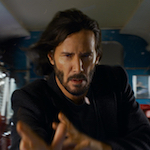 “I’m sorry. How could I know this would happen?”
“I’m sorry. How could I know this would happen?”
“We didn’t understand all of it back then. No more than we do now.”
(you have entered THE SPOILERTRIX)
When I saw the first trailer for THE MATRIX RESURRECTIONS, it wasn’t what I expected. That is to say that it seemed like the sort of thing you would expect from a normal 2020s “legacy sequel” to an old series: bringing back some of the original stars, addressing that they are older now, stripping away some of the excesses of previous sequels, visually and otherwise referencing famous scenes specifically from the first movie. Which is all fine and good, but I figured they must be hiding something, because I didn’t believe Lana Wachowski (working without Lilly, who wanted to take time away from the industry) would come back to THE MATRIX after 18 years just to do something normal. I was betting on her having come up with some weird approach that even if I didn’t like it very much I would respect, as was the case with CLOUD ATLAS and JUPITER ASCENDING.
RESURRECTIONS might be the most accessible movie a Wachowski has made since the original MATRIX, but I don’t think I was wrong. This is a filmmaker making the movie she wants to and not what she thinks anyone else wants, therefore ending up with something no one else would’ve made. And I’m happy to say that I more than respected it. I kind of loved it. Though I wasn’t sure at first.
There’s a rare and thrilling cinematic sensation where an idea teeters over the line into potential ludicrousness and has me thinking I don’t know about this shit, but I hang on and as it sinks in it wins me over. The example that comes to mind is Brian DePalma’s FEMME FATALE, which very late in the game (SPOILERS FOR FEMME FATALE) starts to make it clear that what we’ve been watching has all been a dream. I really thought oh jesus, why would he do this? But I kept watching and as more pieces fell into place it became clear it was the perfect place for the story to go. Landing safely like Evel Knievel.
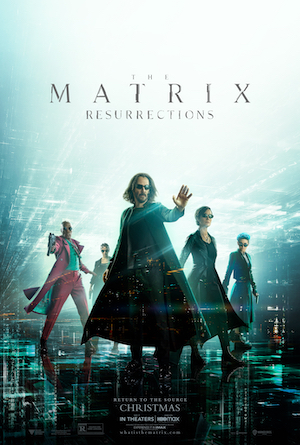 I kind of felt that nervousness here too when it was revealed that Thomas Anderson (Keanu Reeves, STREET KINGS) – who lives a normal life in what seems like our contemporary world and has learned to at least say that his adventures as Neo were imagined (see also: RETURN TO OZ) – is the creator of the mega-popular MATRIX trilogy of video games. We see clips of the MATRIX movies presented as clips from his video games, and he even has Trinity, Morpheus and Sentinel action figures on his desk (the real ones from McFarlane Toys, I think). Ah, so this is what so many people meant in tweets that compared THE MATRIX RESURRECTIONS to WES CRAVEN’S NEW NIGHTMARE. I was pretty sure it was a spoiler, except I couldn’t picture how that would work.
I kind of felt that nervousness here too when it was revealed that Thomas Anderson (Keanu Reeves, STREET KINGS) – who lives a normal life in what seems like our contemporary world and has learned to at least say that his adventures as Neo were imagined (see also: RETURN TO OZ) – is the creator of the mega-popular MATRIX trilogy of video games. We see clips of the MATRIX movies presented as clips from his video games, and he even has Trinity, Morpheus and Sentinel action figures on his desk (the real ones from McFarlane Toys, I think). Ah, so this is what so many people meant in tweets that compared THE MATRIX RESURRECTIONS to WES CRAVEN’S NEW NIGHTMARE. I was pretty sure it was a spoiler, except I couldn’t picture how that would work.
Yes, this is a movie where characters explicitly discuss a “MATRIX 4” and the fact that “our beloved parent company, Warner Bros.” are “gonna do it with or without us” (a true statement). Being that this is an adventurous and obviously personal movie from one of Hollywood’s most don’t-give-a-fuck blockbuster directors, it really seemed possible to me that it would stay on some TRON bullshit where the events in the other movies that meant so much to some of us were just events inside a video game, and now this is the “real” story. I don’t think I could go for that. Luckily this whole meta thing just turns out to be a distraction to keep “Thomas Anderson” from realizing he’s really Neo, resurrected by the machines to power a new version of The Matrix. (Oh shit, that’s meta too.)
Self-reference is not new, nor is it a get out of jail free card. But THE MATRIX really was trying to communicate a certain view of the world through the exact sort of corporate mechanism that The Matrix represented in the movie, so a sincere artist like Wachowski is going to feel a responsibility to address how its meaning has been watered down, misinterpreted, misunderstood, corrupted or ignored.
“After we spoke, I realized… my life wasn’t a life. At some point, I think I gave up searching for something real.”
The Wachowskis were born at the beginning of what has been labelled Generation X. I’m on the younger end. So when I think of entertainment that reflects the attitudes of our generation, I think of the ‘90s, when people around my age were becoming adults and people around Lana and Lilly’s age were making alot of the art that moved us. THE MATRIX was a big one because so many of its preoccupations and influences – computer programming, electronic dance music, anime, Hong Kong action, etc. – were shit that just wasn’t relevant to the Spielberg/Zemeckis generation of filmmakers. And even if all these guy-feeling-unfulfilled-working-in-a-cubicle movies could be traced back to THE GRADUATE or what have you, they were very much grounded in Gen-X attitudes. Neo feeling adrift putting on a tie and going to work in an office building, then having the authorities show up there to threaten him about his private home life, is very much speaking to the fears of people who grew up after Watergate and Vietnam, came to political awareness during years of recession under Republican presidents, and were shaped by punk, hip hop and/or “alternative” music. We knew about hippie ideals and how they’d stepped aside for the yuppie ones. We were suspicious of conformity and rejected selling out, including but not limited to giving up our youthful passions for a steady paycheck being a cog at some soul-less company.
I love that RESURRECTIONS is not a throwback to those attitudes, but an examination of them from an older perspective. In ’99 Neo’s life was empty because he was working in a cubicle anonymously coding for the MetaCortex software company. In RESURRECTIONS, “Thomas Anderson” has what in 1999 might’ve seemed like a dream job, making a good living creating an awesome and even personal video game series. But from a 2021 perspective we see that that might not have been fulfilling either. Even as “a bona fide famous person and considered by most to be the greatest game designer of our generation,” he hasn’t found his true self. All MATRIX movies explore our fears about what is and isn’t real, but that doesn’t just mean our perceptions of the world outside us – it’s also our expressions of the person inside. Finding the real world is fun, but finding the real you is the deeper message, I think.
In THE MATRIX, Agent Smith knows that the computer professional Thomas Anderson is secretly also the hacker Neo, and says that “One of these lives has a future, the other does not.” The beginning of RESURRECTIONS explores what might’ve happened if he was right, and “Thomas Anderson” was the life that survived. These names that the rebels have chosen for themselves (like rappers, super heroes or former Ain’t It Cool writers) represent their true selves. Every time they say “Thomas Anderson” it feels wrong, because that’s not who he is. He’s Neo. The new character Bugs (Jessica Henwick, ON THE ROCKS) knows it; when Morpheus mentions Thomas Anderson she says “maybe you know him by his real name, Neo.” And one of the great adrenaline pumping moments in the movie is when being called “Tiff” one too many times finally reminds a blue-pilled Trinity of who she really is. “I wish you would fucking stop calling me that,” she says. “I hate that name. My name is Trinity.”
I believe there is trans meaning in that. You call a trans person by the name they want to be called, and not their “dead name.” But I also think it’s universal – we want to be seen as the person we want to be, and not the person people perceive us to be, or society expects us to be.
Of course, Smith always called Neo “Mr. Anderson,” and now that Neo’s douchey business partner (Jonathan Groff, AMERICAN SNIPER) turns out to be some sort of reincarnation of Smith, he always calls him “Tom.” A way to casually disrespect him.
Unfortunately Hugo Weaving was committed to a play, and they didn’t wait for him. I don’t know if this was the original plan, but it would be great if he was in it and just straight up played the I-may-wear-a-blazer-but-don’t-worry,-I-don’t-like-ties-and-I-do-like-sneakers business partner. Neo and Agent Smith having tension making video games together, having no idea of their past.
I’ve seen some raves for Groff. I think he’s okay. I like the moment right before he remembers he’s Smith, when he notices a gun dropped on the floor during the police raid, and he eyes it, clearly wanting to pick it up and just start killing people. To me it really expresses this truth that there are certain motherfuckers out there who pretend to be regular nice people but would absolutely jump at the chance to be a fuckin fascist asshole putting a boot on your face.
Though I guess that’s not really what Smith is at this point. He continues to be an anomaly with his own agenda. He talks about “the nature of things” being “Ones and zeroes, light and dark, choice and its absence, Anderson and Smith,” but a major theme of the movie is moving beyond such binaries. That connects to Wachowski’s gender, of course, but I think it extends to an entire philosophy.
In THE MATRIX, the Wachowskis used the classic fantasy tropes of a prophecy and a chosen one. In RELOADED and REVOLUTIONS they seemed possibly troubled by that, having characters philosophize about destiny vs. free will. Here Lana comes up with a really appealing way of looking at it. Bugs rejects “binary conceptions of the world,” but the red pill/blue pill exercise is not “some symbolic reduction of my life” because “The choice is an illusion. You already know what you have to do.”
If you’re the type of person that’s gonna take the red pill, you’re gonna take the red pill. If you’re the type of person that’s gonna convince a corporation to spend $120 million on a SPEED RACER movie that’s a weird visual experiment with an anti-corporate message, you’re gonna do that. “That ain’t a choice,” except that’s you, so it was your choice. I like the part where Neo tries to take the blame for Bugs disobeying, and Niobe tells him “Do not rob my ex-captain of her agency.”
According to a transcript I found online, the word “choice” appears in the movie 11 times. That’s as many times as “machine.” When discussing freeing people, it’s always emphasized that it has to be their choice. Even Trinity. No one is really sure she’ll want to wake up from her life as “Tiffany,” a mother, builder of motorcycles and wife of a dude named Chad who calls her “babe” and is played by Neo-stunt-double-turned-JOHN-WICK-director Chad Stahelski. Maybe Tiffany is the real her. Maybe that’s her choice.
(Nah. No way.)
“Allow me to sum up our goal in a single word: ‘bullet time.’”
In the sequel’s silliest scenes, the Deus Machina development team discuss what THE MATRIX means to people and what THE MATRIX 4 has to be, and it definitely feels like ridicule (and maybe verbatim quotes) of specific real life dipshits the Wachowskis have dealt with over the years. It’s goofy as hell to put all this into a sequel. It’s also a tip off about which things the director does not believe are as important in a MATRIX 4 as other people might. For example, when the obnoxious Jude (Andrew Caldwell, HAUNT) talks about “We need a new ‘bullet time.’ We need to revolutionize gaming again,” it signals that the previous MATRIX ethos of trying to bowl us over with a bullet time or a burly brawl is not really on the agenda anymore. So, fair warning.
Despite the broadness of these scenes, I think they do a good job of illustrating how just having a popular piece of art inherently trivializes the intent of said art. The people shown talking about philosophy, ideas and metaphors in THE MATRIX sound almost as wrong as the ones talking about guns, mayhem and “I like my games big, loud and dumb.” A character played by SPEED RACER’s Christina Ricci shares a focus group “packet” showing that “originality” and “fresh” are the top two words that come up in “keyword association with the brand,” and therefore are “great things to keep in mind as you begin working on MATRIX 4.”
You know – just make one of those original and fresh part 4s. That’s what the brand is all about!
The premise/joke of NEW NIGHTMARE was that telling scary stories about the fictional character of Freddy Krueger had been keeping an ancient primeval force at bay – an evil that was gaining power due to the character being watered down in increasingly silly sequels. It was Craven’s way of taking a swipe at followups he wasn’t involved in while also acknowledging the reality that familiarity tends to weaken horror. I think THE MATRIX is more personal to Wachowski than ELM STREET ever was to Craven, so her meta-commentary is also more personal. It’s not just I don’t like what they did with my creation, it’s you pour your soul into this stuff and the machine/the industry/the culture strips its power away until all you can see is a pile of memes and references and i.p. Your heart has become a “brand.”
“They took your story, something that meant so much to people like me,” Bugs says to Neo, “and turned it into something trivial. That’s what the Matrix does. It weaponizes every idea. Every dream. Everything that’s important to us.”
So true, Bugs. But then she says, “Where better to bury truth than inside something as ordinary as a video game?” And that last part strikes me as contradicting, or at least questioning, the very idea of making something like THE MATRIX. The Wachowskis were trying to deliver (not bury) their truth in something as ordinary as some videos games, and some movies, and an anime. And I have to believe that at least Lana still believes in that possibility. She could’ve collected a fat check with an executive producer credit on the LAST ACTION HERO and READY PLAYER ONE writer’s Morpheus prequel or whatever they announced a few years ago. Instead she made this.
The point is that one could never make a movie like THE MATRIX just by setting out to make a movie like THE MATRIX. You could only do it if you really have something you need to say. And I think the specifics of RESURRECTION, both positive and negative, come down to it being what Wachowski needs to say at this moment.
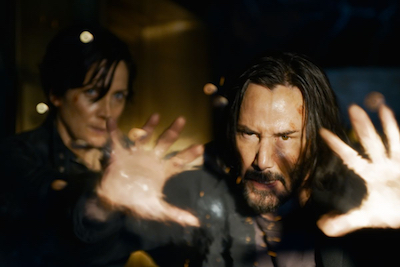 “Now, for the bad news. Your brain is hooked on this shit the Matrix has been force-feeding you for years. Hooked bad. You’re going through major withdrawals.”
“Now, for the bad news. Your brain is hooked on this shit the Matrix has been force-feeding you for years. Hooked bad. You’re going through major withdrawals.”
I love sequels that riskily switch things up from their predecessors. But here it’s a shock because the changes are mostly a rebellion against the masterful visual craft that still makes the previous MATRIX movies stand out. The camerawork is intentionally closer and less precise, emphasizing emotion and performance over slickness. That choice has a legitimate philosophy behind it, but it can’t help but be disappointing to those of us who love the original style and place a high value on clarity and storytelling in martial arts sequences. Just because we love the substance doesn’t mean we don’t care about the surface.
Though Wachowski brought back comic book legends Geof Darrow and Steve Skroce as designers, she did not get the original trilogy’s brilliant cinematographer Bill Pope, opting instead for her more recent collaborator John Toll (THE THIN RED LINE, RISE: BLOOD HUNTER). When Toll couldn’t come back after a months long pandemic break 17 days into shooting, Wachowski promoted Daniele Massaccesi, who had been a camera operator on SPEED RACER and JUPITER ASCENDING.
(Trivia: he’s the son of Italian exploitation legend Joe D’Amato [ABSURD], and got his start working on camera crews in Italy [STAGEFRIGHT, CASTLE FREAK, even the blatantly MATRIX inspired EQUILIBRIUM]).
Massaccesi told Indiewire that Wachowski had developed a more improvisational, steadicam-based style on her Netflix series Sense8, and told him not to mimic the previous MATRIXes. “Don’t worry about those, this is a different movie.”
New cast member Groff also commented on the changing style in a profile in Entertainment Weekly.
“She was explaining to us how, in her earlier work, she would storyboard things like they were comic books almost, and create exact frames of what she wanted as her way of literally controlling her narrative, because there was so much out of control inside of her. Then when she embraced her identity, this articulated itself in her work and opened her up to the idea of capturing the things that can’t be controlled.”
The Indiewire piece explains that Massaccesi lights the scenes so that “if an actor wants to move in an unexpected way, I accommodate them.” Co-star Henwick confirmed to Collider that Wachowski liked to set up for 360 degrees of coverage, saying she’d sometimes leave the camera running for 20 minutes straight. “It’s very much how she feels in the moment. It’s very instinctive for her. It’s fascinating to watch. I’ve never worked with a director who is going so much on a gut feeling.” Very much the opposite of the first film, where they famously storyboarded every shot just to explain to executives what the fuck they were talking about.
I can see why that’s too much for some people to get past. I’m kinda surprised I’m not among you. But I didn’t want Wachowski to pander to anybody, and I’m included in anybody. When I think of RELOADED, my mind goes straight to the spectacular freeway sequence. For RESURRECTIONS one of the first things I think of is a scene that’s just about Neo and Trinity, believing they’re Thomas and Tiffany, having a conversation at a coffee shop. It’s a testament to the power of these characters and the ability of Reeves, Moss and Wachowski to deepen their humanity and their connection.
But I love action, so I do wish more of the action scenes (which are directed by Wachowski, not a second unit) hit me as hard as that. Surprisingly, the film’s low point is when Neo and the rebels have a big fight against exile programs, including Tiger Chen playing presumably his same character from RELOADED. But unlike the mesmerizing chateau fight, this one is shot close up and jittery and I had to really study it to find the part where you could make out his face for like half a second.
(Chen is credited as M.O.T.C., which I tried to decode for a while before I realized it’s the initials of the great movie he stars in from director Keanu Reeves. Duh.)
Nobody could fill Yuen Woo Ping’s shoes, though choreographer Joshua Grothe (Sense8) and stunt coordinators Scott Rogers and Jonathan Eusebio (JOHN WICK, BIRDS OF PREY) do work in lots of cool running up walls and twirling over cars and shit, and Reeves does quite a bit of hand-to-hand, as you’d hope. Bugs slides down the sign from the first film’s Heart o’ the City Hotel, busting light bulbs in what I took as an homage to POLICE STORY. But, whether it’s meant as a change of pace or a comment on modern action or what, Wachowski trades the awed slo-mo for more of a chaotic run and gun style. I think it’s most effective in Neo’s one-on-ones. I did like the big sequence where the rebels travel dark streets mobbed by hordes of bots in almost a fast zombie type of battle, and The Matrix using its residents as artillery shells is a terrifying new development. But I can’t say it wouldn’t be improved by more carefully planned shots.
Big action spectacle and Yuen Woo Ping choreography are not all I love about the MATRIX trilogy, but they certainly are a big part of it. So the miracle here is how much RESURRECTIONS still works for me without them.
Well, not entirely without them. It climaxes in a truly incredible stunt – Reeves and Moss themselves jumping off a 43 story highrise in San Francisco, suspended by wires, something they shot “around 19 or 20 times” according to Reeves, at sunrise so they could use the natural lighting. Though it doesn’t have that green screen look we’re used to, Wachowski is so much more interested in the emotions of the characters than in showing off what they did that I suspect many viewers won’t even realize it was a stunt. Which kinda makes it even more impressive.
 “Everything was simpler back then. People wanted to be free. It’s different now.”
“Everything was simpler back then. People wanted to be free. It’s different now.”
Only Wachowski (or maybe Spike Lee) would give us a cool new next-gen character and name her “Bugs.” It’s maybe a joke about the WB corporation, the Alice in Wonderland rabbit symbolism, and spying and programming lingo. Or maybe it’s just a good weird name for a futuristic kung fu lady with blue hair who awakens Neo for the second time and helps change the world again. Either way, I approve.
After “Thomas” meets a Morpheus-Smith hybrid (Yahya Abdul-Mateen II, AQUAMAN, US) program that he himself created (see also: COOL WORLD, MONKEYBONE) he is re-woke and Bugs switches from audience surrogate to tour guide of the new reality 60 years after REVOLUTIONS. Though I’m overall positive on the STAR WARS sequel trilogy, it bums me out how it basically voids what was the triumphant ending of Lucas’ trilogy/sextet – turns out the Empire just got a new name and helmets and the war went on for generations more. So I really appreciate the scene in RESURRECTIONS where Neo worries that “It feels like everything I did, everything we did, like none of it mattered,” but Bugs shows him how he “changed everything.” The truce he created with the machines (who now prefer to be called Synthients) “had a huge impact on their world” – so much so that three of them are on Bugs’ hovercraft crew, and were instrumental in rescuing him. (I love that this also fulfills the promise of my favorite ANIMATRIX short, Matriculated, where humans tried to recruit robots to their side.)
Jada Pinkett Smith (DEMON KNIGHT) returns as Niobe, now a general and wearing old-age makeup since she’s, what, in her 90s? Now the leader of an underground city called Io, she gets more of a character to play than before, and she’s an interesting part of the story because she’s an obstacle to what Bugs and Neo want to do (partly filling the role of her ex, Commander Lock in RELOADED and REVOLUTIONS) without being wrong. She argues that just as the bullshit, the “noise the Matrix pumps into your head,” keeps the coppertops distracted in The Matrix, war was keeping the red pills distracted in Zion. “Zion was stuck in the past. Stuck in war. Stuck in a Matrix of its own. They believed that it had to be us or them. This city was built by us and them.”
Her primary responsibility is to maintain peace for Io, where life is way better than in the old days because of all the cool shit humans and Synthients can do by working together – including the de-extinction of strawberries. In fact they’re so inclusive of artificial intelligence (or “digital sentience”) here that they’ve developed a technology of floating magnetic BBs so programs like the new Morpheus can have a physical presence in the real world and make contributions of their own.
(Side note: Imagine the raves they must have in this place! Synthients and programs dancing all up on each other. That’s one thing I missed, this is the only MATRIX without any dancing.)
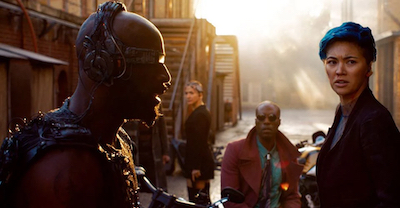 I love the generational differences in this story. Bugs and her crew are younger, so in some ways more militant than previous generations. They like going into the Matrix where they have cool sunglasses and various lines shaved into their hair, can jump through mirrors and fire off bullets by the hundreds. They disobey the “protocols” to achieve their dream of proving that Neo is still alive.
I love the generational differences in this story. Bugs and her crew are younger, so in some ways more militant than previous generations. They like going into the Matrix where they have cool sunglasses and various lines shaved into their hair, can jump through mirrors and fire off bullets by the hundreds. They disobey the “protocols” to achieve their dream of proving that Neo is still alive.
Niobe did shit like that when she was young, but “the world was different then. We were different.” Bugs says Niobe cares more about growing fruit than freeing minds. But both are important. They each have their role in creating a better world.
Though Bugs and her generation have grown up in a different status quo, working with Synthients, they also study Neo’s life and largely follow original recipe Morpheus’ methods, beliefs and style. Niobe (like Wachowski, I’m pretty sure) believes that we must continue to evolve in our thinking. Morpheus was a great man who changed the world, but stayed stuck in what became the old ways (the prophecy of The One), dooming Zion. Niobe’s Io advances us beyond the 1999 need to rage against the machine into the next step of using our ingenuity and creativity to make the world better. As governments and companies increasingly paint us into a corner on climate change, that seems like a better thing for sci-fi to focus on than uprising.
No, scratch that. It seems like an additional important thing for sci-fi to focus on.
Though they disobey her, the younger generation also have great respect for Niobe, and have inherited some of her optimism and belief in problem solving. When Bugs explains to Neo that they have no idea how they could rescue Trinity, another member of her crew, Lexy (Erendira Ibarra, Sense8), says, “Yet. Nobody believed we’d ever find him, but we did.”
And Bugs says, “Okay. We don’t know how to get her out… yet.” I found that very inspiring.
Like Niobe, Neo has gained wisdom over time. He tells new-Morpheus “I’m done fighting,” and he seems to mean it. His kung fu is mostly defensive, and he uses his trademark bullet-blocking force field hands constantly. I feel dumb that I didn’t notice on the first viewing that neither Neo or Trinity ever pick up a gun in this one. There’s plenty of gunplay between the young rebels and the modern hyper-militarized stormtrooper cops, but Neo and Trinity are beyond that. Despite whatever misgivings I may have about how the focus on self defense affects the action scenes, I respect the hell out of it. Yet another reason why Neo is the coolest.
“I remember this. I remember us. My dream ended here.”
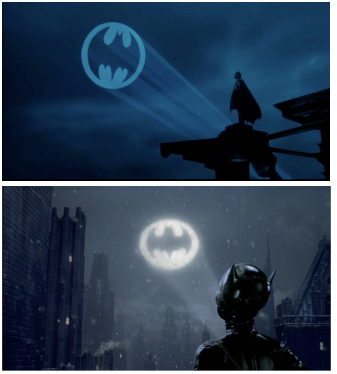 I always loved that BATMAN RETURNS took the ending of BATMAN and flipped it, so Batman is the one in the car mooning over a woman and the woman (the Catwoman, to be specific) is the one up on a building in front of the bat signal looking awesome. RESURRECTIONS kind of does something like that to the ending of THE MATRIX, where Neo flew up into the sky, into the camera. He does that again but this time he’s following behind Trinity.
I always loved that BATMAN RETURNS took the ending of BATMAN and flipped it, so Batman is the one in the car mooning over a woman and the woman (the Catwoman, to be specific) is the one up on a building in front of the bat signal looking awesome. RESURRECTIONS kind of does something like that to the ending of THE MATRIX, where Neo flew up into the sky, into the camera. He does that again but this time he’s following behind Trinity.
Though that sort of referencing has become far from novel in the decades since BATMAN RETURNS, this one kind of overachieves in the amount of levels it works on. First, you’ve got the standard “it’s cool because this time they’re giving the hero treatment to the woman.” Second, the autobiographical aspect of Wachowski (according to the meta narrative of the movie) having put alot of herself into the character of Neo, and now placing Trinity front and center instead. Third, the retroactive implication that Neo wasn’t The One and then lost his powers – it now seems those powers always came from the combination of Neo and Trinity. This is a love story where having a soul mate is just as heavy as being the chosen one.
What I love most about it though is how it works as an end to the series (assuming that’s what it is). I have no idea if Lana actually had any interest in doing further chapters where Neo and Trinity paint the sky with rainbows as they promised (which, of course, I’d be down for), but even if she did, I doubt she sees the apparent box office failure as much of a loss. I’m not saying she’d be mad if RESURRECTIONS was so popular that Bugs-as-in-the-bunny replaced the actual Bugs Bunny as the WB mascot. She’d probly get a kick out of that. But I’m positive she can be proud to have made a small movie that some of us loved and that tanked hard enough to make any further “brand” exploitation by WB unlikely for a while. That’s definitely a victory.
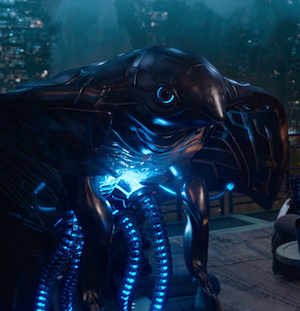 And for the rest of us, I figure the ending will stand as a reset back to that glorious pre-sequel time when we got to let our imaginations fly off into the sky with Neo and wonder what happens next. It’s a blank canvas once again, but this time maybe we’ll come to it with the wisdom of age, the optimism of Io, and the support of a weird looking Synthient friend named Kujaku.
And for the rest of us, I figure the ending will stand as a reset back to that glorious pre-sequel time when we got to let our imaginations fly off into the sky with Neo and wonder what happens next. It’s a blank canvas once again, but this time maybe we’ll come to it with the wisdom of age, the optimism of Io, and the support of a weird looking Synthient friend named Kujaku.
P.S. a few other random notes
As with the Kid’s Story short in THE ANIMATRIX, I think it’s a little scary that a primary method of “freeing your mind” in this chapter is jumping off a building. It works well for the story but considering the way some people have responded to THE MATRIX and “simulation theory” I can’t help but worry what some mind somewhere might do with that. Wachowski even maybe acknowledges this by having The Analyst (Neil Patrick Harris, Capitol Critters) say, “There’s nothing wrong with that. It’s what artists do. But it becomes a problem when fantasies endanger us or other people.” (Of course, The Analyst is the bad guy.)
Which brings me to one way this is a throwback to 1999 attitudes: the portrayal of a psychiatrist making Neo suppress his true self. The Analyst is secretly the architect of the new Matrix, lying to Neo about reality and prescribing pills to keep him under control. It’s convenient for the plot but does seem like a deliberate swipe at psychiatry. I saw one tweet suggesting that’s a trans thing, so I won’t pass judgment on that. But I know so many people who really have freed themselves by working through issues with therapists and using medical science to balance their chemistry. It’s a shame to scare people away from something that could really improve their lives.
On a more positive note, I had actual goosebumps on my arms when the end credits hit. Though I found the ending satisfying and exciting, it was definitely more about the song playing. There’s nostalgia there since it’s a cover of “Wake Up,” the song from the original movie, and I had actually wondered if they would bring back some form of Rage Against the Machine. It even occurred to me maybe Run the Jewels featuring Zack de la Rocha could be one updated version. It did not occur to me that they would get Brass Against, whose Youtube videos I have watched many times because of how much I love the idea of a brass band covering songs like Rage’s “Killing in the Name Of” and Black Sabbath’s “War Pigs.” (And yes, I know that the band recently made headlines because their singer peed on a guy on stage. Not my thing but who cares, I’m glad she didn’t eat a bat or something.)
I loved hearing that blasting in a theater – it’s an acknowledgment of the song’s importance to the original MATRIX, the greatness of the song, and the greatness of this cover. Obviously it works on a couple different levels that it’s a woman vocalist (who really fuckin nails it, in my opinion), and I would add that this is also a version of the song that brings together more musicians and more styles to achieve its goals. Kind of an Io approach. Long live Io.


























December 29th, 2021 at 8:02 pm
Great review, Vern (: